|
WPA Art Passes the
Test of Time
by Bob Brooke
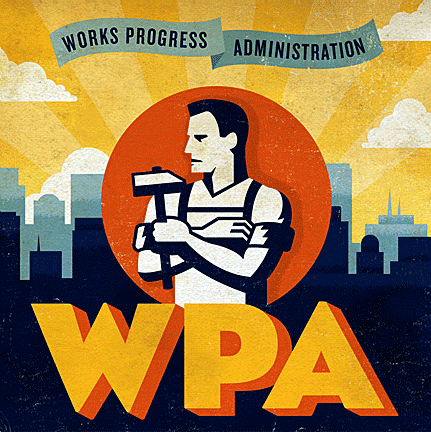 The
year is 1935 and the Great Depression is in full swing. In an effort to
help provide economic relief to the citizens of the United States,
Congress created the Works Progress Administration (WPA) as part of
President Franklin Roosevelt's New Deal. Today, collectors admire the
wonderful art produced as a result of this program during that depressed
time. The
year is 1935 and the Great Depression is in full swing. In an effort to
help provide economic relief to the citizens of the United States,
Congress created the Works Progress Administration (WPA) as part of
President Franklin Roosevelt's New Deal. Today, collectors admire the
wonderful art produced as a result of this program during that depressed
time.
In March of 1933, soon after Roosevelt's inauguration, the New Deal came
into being.
The President’s goal, with the help of Congress, was to restore the
banking system, help Americans in need, and turn around a very depressed
economy.
The unemployment rate in 1935 was at a staggering 20 percent. Congress
designed the WPA to provide relief for the unemployed by providing jobs
and income for millions of Americans. At its height in late 1938, more
than 3.3 million Americans worked for the WPA.
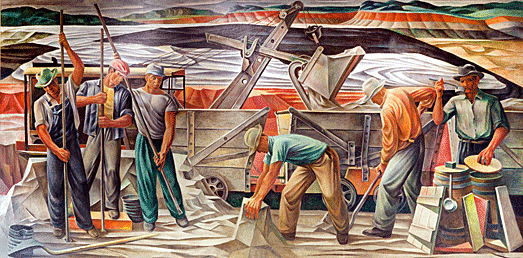
The Works Progress Administration or WPA, renamed in 1939 as the Work
Projects Administration, was the largest and most ambitious American New
Deal agency, employing millions of mostly unskilled men to carry out
public works projects, including the construction of public buildings
and roads. In a much smaller project, Federal Project Number One, the
WPA employed musicians, artists, writers, actors and directors in large
arts, drama, media, and literacy projects.
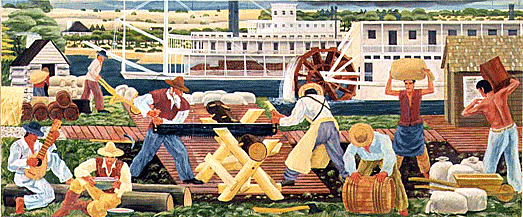
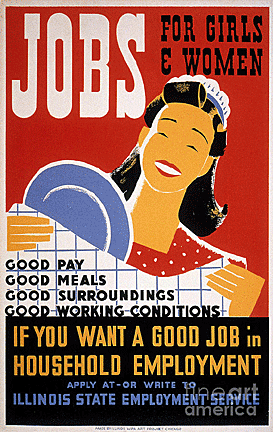 What
the New Deal did produce, however, was wonderful collecting genres
through the WPA. The WPA was one of the more successful New Deal
programs because it created jobs and was not just a handout of cash. The
government supplied funds to local governments stating the money was to
be used to find useful work for people. The funds were not to train
people to work, but to pay people to use the skills they already had. What
the New Deal did produce, however, was wonderful collecting genres
through the WPA. The WPA was one of the more successful New Deal
programs because it created jobs and was not just a handout of cash. The
government supplied funds to local governments stating the money was to
be used to find useful work for people. The funds were not to train
people to work, but to pay people to use the skills they already had.
Another stipulation to the funding was the jobs performed should benefit
the community. The WPA didn’t set out to create attractive jobs meant to
generate a large income. Doing so would have put the government in
competition with private industry, which was also struggling. Instead
WPA jobs were to help people make enough income to feed their families
without hurting their self respect and hopefully, keeping these people
off of other government programs.
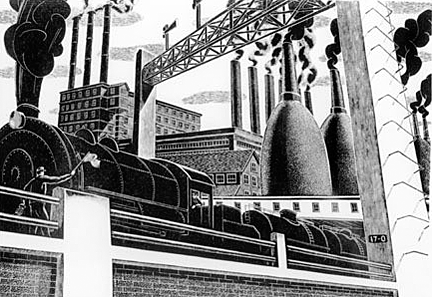 According
to the program’s guide, the "WPA was a compilation of varied work
projects that provided employment for artists, musicians, actors,
authors, and laborers which helped to put 8.5 million men, women and
youth back to work. "Those working through the WPA created public
buildings, public parks, roadside rest areas, and the like.” National
and state parks were prime benefactors through the building of
campsites, roads, and visitor centers. According
to the program’s guide, the "WPA was a compilation of varied work
projects that provided employment for artists, musicians, actors,
authors, and laborers which helped to put 8.5 million men, women and
youth back to work. "Those working through the WPA created public
buildings, public parks, roadside rest areas, and the like.” National
and state parks were prime benefactors through the building of
campsites, roads, and visitor centers.
WPA workers built more than 4,000 new
schools, erected 130 new hospitals, laid roughly 9,000 miles of storm
drains and sanitary sewer lines, built 29,000 new bridges, constructed
150 new airfields, paved or repaired 280,000 miles of roads and planted
24 million trees. All this for an average salary of $41.57 a month.
As weapons production for World War II began ramping up and unemployment
dropped, the federal government decided a national relief program was no
longer needed. The WPA shut down in June of 1943. At that time,
unemployment was less than two percent as many Americans went to work in
the armed services and defense industries.
Federal Project Number One
In addition to its well-known building and infrastructure projects, the
WPA also oversaw a group of programs collectively known as Federal
Project Number One. These programs employed artists, musicians, actors
and writers.
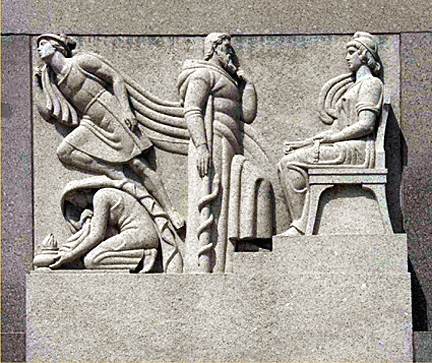 Roosevelt
intended Federal One to put artists back to work while entertaining and
inspiring the larger population by creating a hopeful view of life
amidst the economic turmoil. Roosevelt
intended Federal One to put artists back to work while entertaining and
inspiring the larger population by creating a hopeful view of life
amidst the economic turmoil.
Artists created motivational posters and painted murals of “American
scenes” in public buildings, especially post offices. Sculptors created
monuments, and actors and musicians performed classic and new plays.
Federal One also established more than 100 community art centers
throughout the country.
First Lady Eleanor Roosevelt lobbied FDR to sign the executive order
establishing Federal One. She later praised the project in columns and
speeches and defended it against critics who saw the arts as a waste of
money.
Federal One comprised a small part of WPA expenditures. Roughly $27
million of the nearly $5 billion that had been earmarked for WPA work
programs went to the arts. The WPA arts programs led to the later
creation of the National Foundation of the Arts.
WPA Architecture
Historians often refer to the architecture of many U.S. buildings
constructed as part of Great Depression relief projects as “PWA Moderne”—for
Public Works Administration Moderne---or “Depression Moderne.” The style
blended neoclassical and Art Deco elements.
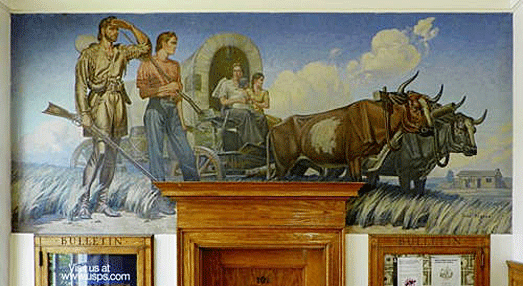
While inequities existed under the programs, many women, blacks and
other minorities found employment with the WPA. In 1935, the WPA
employed approximately 350,000 African Americans, about 15 percent of
its total workforce. The Federal Music and Theatre projects also
supported black musicians and actors.
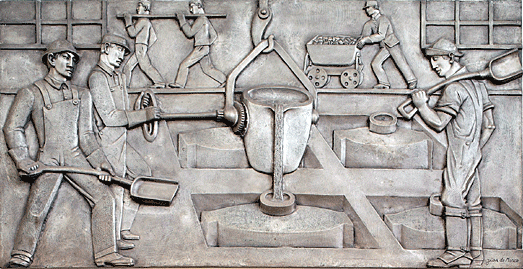
A Gallup poll in 1939 asked Americans what they liked best and worst
about FDR’s New Deal. The answer to both questions was “the WPA.”
Some politicians criticized the WPA for its inefficiencies. WPA
construction projects sometimes ran three to four times the cost of
private work. Some of this was intentional. The WPA avoided cost-saving
technologies and machinery in order to hire more workers.
Federal Art Project
This project was directed by Holger Cahill and in 1936, the peak for
employment in this federal project, the Federal Art Project employed
over 5,300 artists. The Arts Service Division created illustrations and
posters for the WPA writers, musicians, and theaters. The Exhibition
Division had public exhibitions of artwork from the WPA, and artists
from the Art Teaching Division were employed in settlement houses and
community centers to give classes to an estimated 50,000 children and
adults. They set up over 100 art centers around the country that served
an estimated eight million individuals.

The WPA paid low wages and wasn’t able to
employ everyone—some five million were left to seek assistance from
state relief programs, which provided families with $10 per week.
However, it went a long way toward bolstering the self-esteem of workers
throughout the country. The WPA program in the arts led to the creation
of the National Foundation for the Arts and the National Endowment for
the Humanities.
<
More Special Features
Next Article >
|
